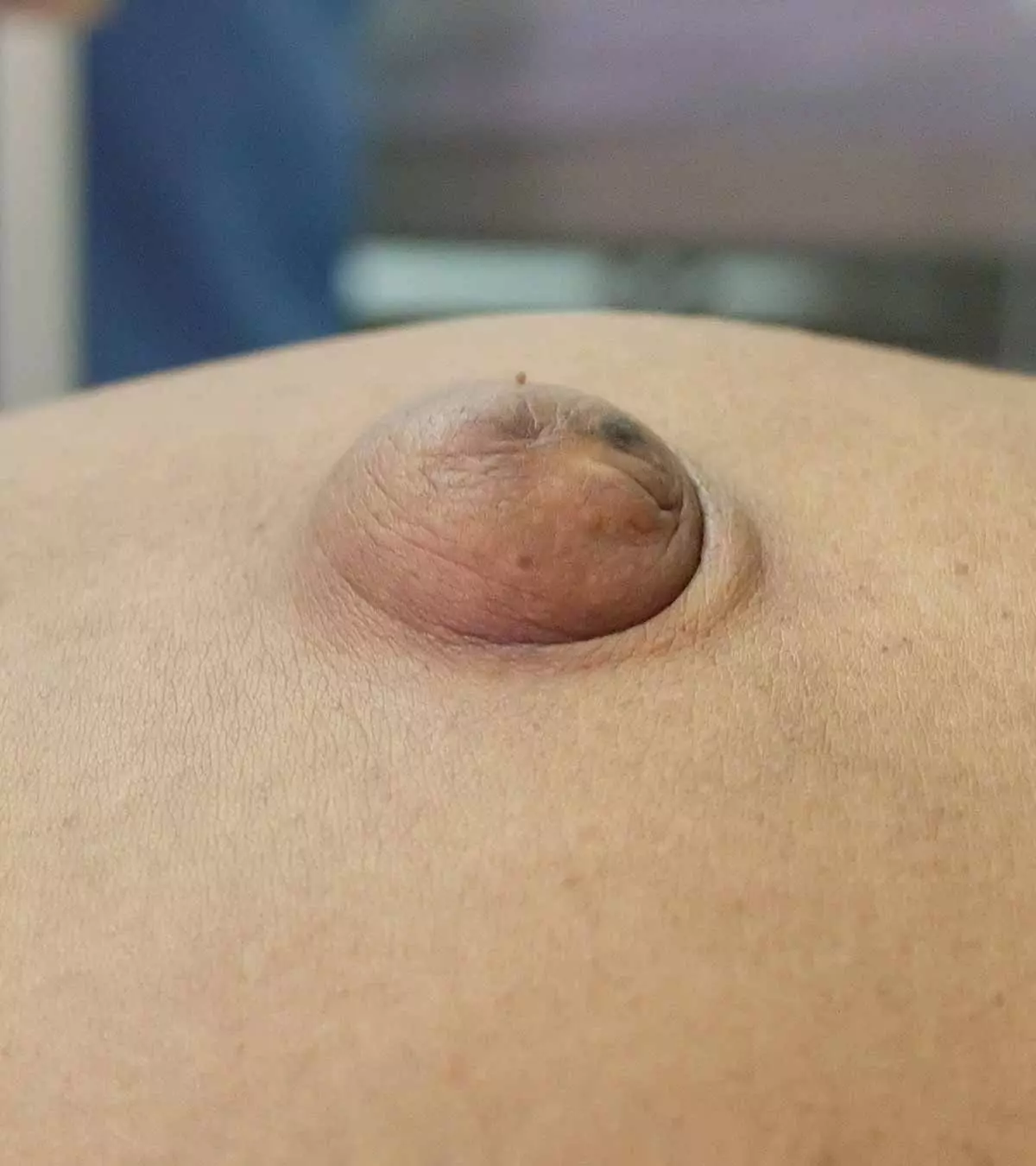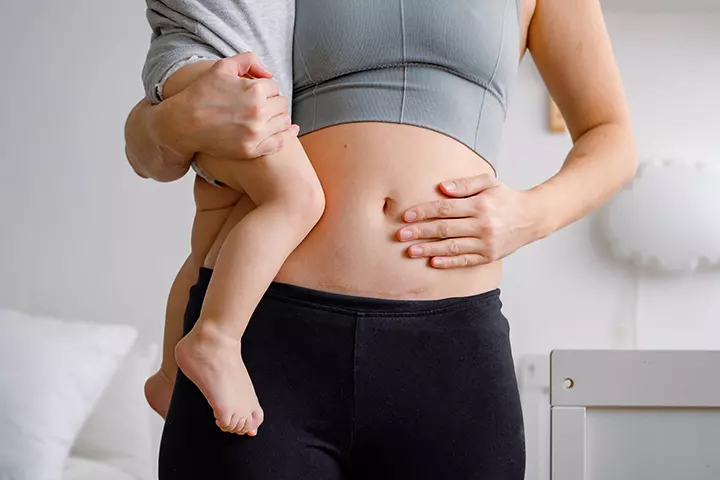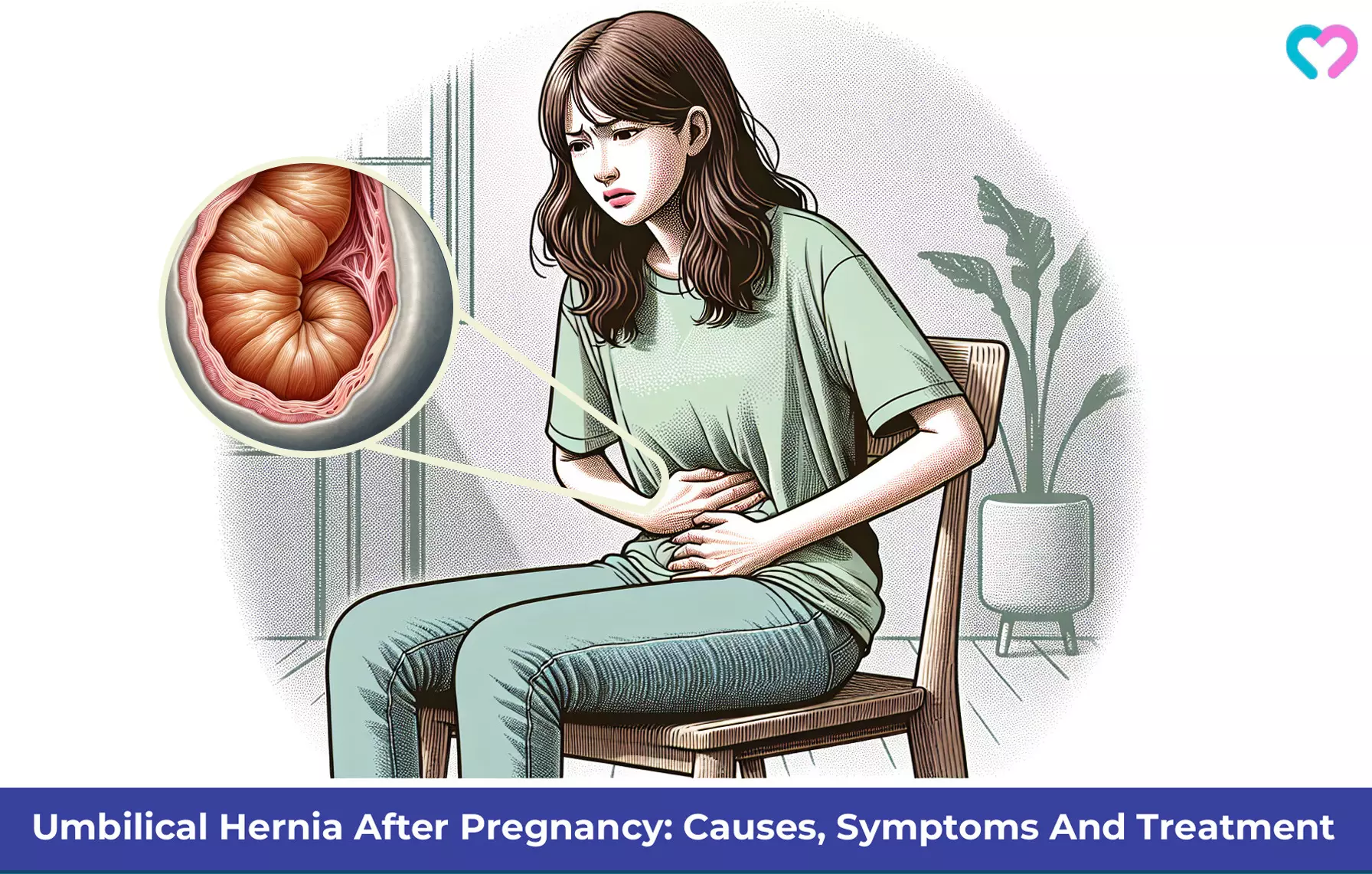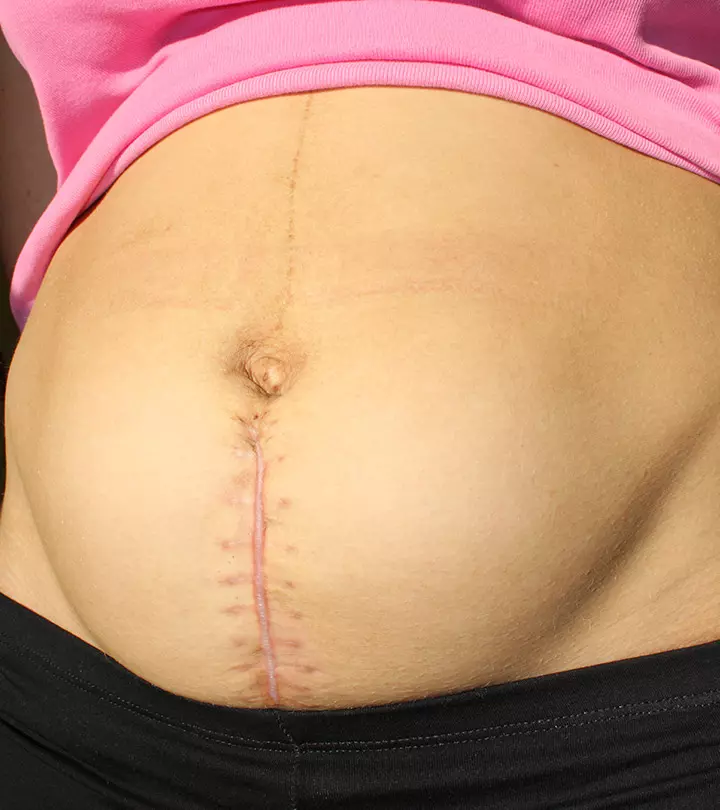
Image: ShutterStock
Hernia refers to a condition where an organ or tissue squeezes out of an abnormal opening or weak spot in the connective tissue or muscle. A postpartum umbilical hernia is a type of hernia that occurs due to extreme pressure on the abdominal wall. However, some effects of the female intimate area or c-section pregnancy can also cause it.

Generally, an umbilical hernia isn’t a serious or life-threatening issue. However, it warrants prompt medical interventions to prevent adverse complications.
Read on to learn more about the possible causes of umbilical hernia after delivery, including its symptoms, treatment, and recovery process.
Key Pointers
- Pressure on the abdominal wall during pregnancy can cause postpartum umbilical hernia, where an organ or tissue bulges out.
- The most noticeable sign of umbilical hernia is a protruding belly button.
- Symptoms of a strangulated hernia include stiffness, excruciating pain, nausea, vomiting, constipation, and bloody stools.
- A doctor should examine a hernia that doesn’t disrupt blood flow to decide on the necessary treatment.
- If left untreated, a hernia that disrupts blood flow to the intestine can lead to severe abdominal pain and gastrointestinal complications.
What Is Postpartum Umbilical Hernia?
Postpartum umbilical hernia is characterized by the outward protrusion of the belly button (umbilicus) through an opening in the abdominal muscles, post-delivery.
The soft and tender bulge is generally small in size. However, the lower abdomen feels quite stretched out and strained every time one lifts heavy objects, sneezes, or coughs.
 Quick fact
Quick factWhat Causes Postpartum Umbilical Hernia?

Postpartum umbilical hernia occurs when the pressure builds up within the growing tummy, and the pelvic region protrudes an organ through the opening created in the abdominal wall (1).
Umbilical hernia can be triggered by certain factors that put intra-abdominal pressure, such as:
- Some individuals have a small gap or a hole in the abdominal muscle or tissue after the detachment of umbilical cord at birth. Dr. Dana A. Telem, director of the comprehensive hernia program at Michigan Medicine and an associate professor of surgery, says, “Because you already have a natural weakness there, that expansion in your belly can be the tipping point.”
- The abdominal muscles tend to lose their elasticity in overweight or obese individuals. Obesity also increases the chances of a recurrence of umbilical hernia (2).
- Postpartum umbilical hernia might happen in women who underwent abdominal surgery or cesarean section in the past (3).
- It may also result from the accumulation of fluids in the abdominal organs and cavity (ascites).
- Chronic abdominal wall distension and the weakness of the connective tissue may cause the hernia (4).
- If you had a hernia after your previous delivery, then you may have it again.
- Diastasis recti is when the rectus abdominis muscles separate during pregnancy, causing the belly to stick out or bulge. Exercise can fix it, but severe cases can lead to an umbilical hernia.
A good way to detect umbilical hernia early is by staying alert to its symptoms.
Symptoms of Postpartum Umbilical Hernia
A protruding belly button is the most prominent sign of an umbilical hernia. If the hernia is small, it is usually asymptomatic (4).
McKenzie Wheeler, a mother of two, shares her experience with postpartum umbilical hernia. She says, “I came home from a workout and had what looked like a green grape under my skin above my belly button. Sensitive to the touch, I knew immediately what it was. Upon calling my Ob’s office, they referred me to a specialist for further evaluation (i).” The medical evaluation confirmed the diagnosis of an umbilical hernia.
Large-sized hernias might have some symptoms such as:
- The skin around the protrusion may appear reddish-blue. There could be stiffness and excruciating pain in case the hernia disrupts the blood flow to the intestine (strangulated hernia).
- Postpartum umbilical hernia, especially a strangulated one, may also result in nausea and vomiting. One may also have to deal with constipation and blood in motion. This could be a medical emergency and require immediate medical attention.
- There is often a loosening of the skin around the affected region with an outward protrusion in women with umbilical hernias after C-section delivery.
Diagnosis Of Umbilical Hernia
Your doctor may examine the bulge near your navel. You might be asked to stand and breathe to observe changes in the bulge. Your doctor will also assess whether the hernia can be pushed back into the abdomen, review your medical history to check if it’s strangulated, and design a suitable treatment plan.
If needed, you may be advised to undergo a blood test to check for infections or imaging tests, such as a CT scan or MRI, to get a clearer view of the intestine (7).
Will Umbilical Hernia Go Away After Pregnancy?
Tiny hernias with no pain or disturbance to your daily life may not need immediate surgery. The umbilical hernia that does not disrupt the blood flow to the intestine is generally less severe and rarely requires surgical procedures. However, you should get it inspected by a doctor, who can decide if it requires medical intervention.
A healthy lifestyle and regular exercise with a few yoga poses are widely believed to strengthen abdominal muscles. There is no direct research done on the benefits of exercise on curing postpartum umbilical hernia. Each hernia is different and may restrict an individual’s movement to a certain extent. Therefore, do not attempt any exercise without asking the doctor.
Exercises Usually Recommended For Minor Umbilical Hernias
Here are some exercises that are often considered by women with minor umbilical hernias. These exercises neither cure the hernia nor are a replacement for doctor’s advice. Exercise, in general, is good for the muscles of the body. Hence, you may consider these exercises to improve postpartum abdominal muscle tone, which may help subside minor umbilical hernias.
- Cycling your legs: Lie down on a flat board or a floor mat and slowly raise your legs towards your chest. While holding your sides, keep pedaling your legs. Doing the bicycling exercise, for 10-12 minutes, twice or thrice a week might help strengthen the muscles of the lower abdomen significantly.

- Breathing exercise: Breathing from your chest while exercising can exert undue pressure on the abdomen. The correct technique involves breathing from your abdomen. For the breathing exercise, sit straight or lie on your back. Carefully place one hand on the belly and the other on your chest. Now inhale, ensuring your abdomen is filled with the air. Make sure the hand on your belly rises as you breathe in the air. Wait for a few seconds, and exhale slowly as your abdomen goes back to its position.

- Boat pose: Boat pose helps strengthen the abdominal muscles. Sit on the floor by placing your legs straight in front of you. With your hands underneath your thighs, raise your legs gently towards your chest. Keep your legs in a straight position. Hold the position for ten seconds and then slowly release, going back to the original posture. You can perform the boat posture five to ten times.

You may avoid:
- Exercises and aerobics that end up extensively stretching and straining the pelvic floor and abs. Also avoid the crunches that exert undue pressure on the pelvic floor.
- Lifting of heaving objects.
- Constipation can make you strain the abdominal muscles while trying for a bowel movement. Eat fibrous foods and drinking adequate water to avoid constipation.
Exercises may help in minor cases of umbilical hernia. Severe hernia, recurrent hernia, or minor umbilical hernia with pain is likely to require surgical intervention.
Surgical Treatment Of Postpartum Umbilical Hernia
If the hernia is large and painful, then your doctor may consider surgical treatment (3). The treatment involves fixing the weakened muscles with a mesh or closing the gap with sutures.
The mesh repair requires placing a mesh over the breached section of the abdominal muscle. A suture-based surgery involves stitching the open muscle or tissue with a medical suture (stitches).
The surgeries could be conducted through an open incision or a laparoscopic procedure, which involves a small incision. The recovery is likely to be quicker with a laparoscopic procedure.
Mesh repair is considered more effective than suture repair alone (5).
Exercise may help improve the condition of umbilical hernia post-surgery. The doctor can guide you about the right mix of exercises that are best suited for the specific case of umbilical hernia.
 Did you know?
Did you know?What Happens If The Condition Is Left Untreated?

Postpartum umbilical hernia accompanied by severe pain, and disruption of blood flow to the intestine (strangulated hernia) needs immediate medical attention or surgery. In some cases, an untreated hernia may obstruct the bowel movement, cause intense abdominal pain, and gastrointestinal problems.
How Long Does It Take For Full Recovery?
In the case of laparoscopic surgery, you may be able to walk after the surgery but might need three weeks’ time to begin your other physical activities. You may need to rest for one to two weeks (6). The recovery time is longer in the case of open surgery. You should avoid rigorous activities, lifting heavy objects, or climbing steps during your recovery period.
Wheeler underwent laparoscopic surgery to treat her hernia, which took approximately four hours in the day surgery unit. She notes, “Mild to moderate swelling dissipated after 4-5 days, I’m still sore to the touch, but can move around pretty well. I also have a weight restriction of 10 lbs for 3-4 weeks.”
Hernia Repair Surgery and Fertility
There is no evidence to suggest that hernia repair surgery could cause loss of fertility or problem conceiving. However, there is the likelihood of you having umbilical hernia in the subsequent pregnancies too. It is thus ideal to consult a doctor if you wish to conceive after a hernia repair surgery.
Frequently Asked Questions
1. How do I know if my umbilical hernia is strangulated?
You can recognize a strangulated umbilical hernia through symptoms such as a full, round abdomen that is tender or painful, a dark or discolored bulge, fever, constipation, and vomiting (7).
2. Does umbilical hernia make your stomach big?
Since postpartum umbilical hernia creates a bulge near the navel, your stomach may appear more protruded and round.
3. What foods should I avoid if I have an umbilical hernia?
If you have a postpartum umbilical hernia, avoid foods that cause inflammation, such as red meat, high-fat dairy products, and processed foods. Also, opt for complex carbohydrates instead of refined flour, pasta, and instant rice. Further, avoid acidic and sugary foods and drinks (8).
4. Can hernia affect future pregnancies?
If the hernia is asymptomatic and doesn’t need repair, it likely won’t cause problems. However, if surgically repaired, it may lead to pain or discomfort during subsequent pregnancies. Healthcare providers usually recommend planning a pregnancy a year after hernia surgery to ensure proper healing and reduce the risk of recurrence (9).
A postpartum umbilical hernia is not uncommon. In most cases, there is no reason to worry. The most common sign is an outie or a protruding belly button. At times, there may be reddish-blue discoloration, stiffness, or severe pain. If you have any other accompanying symptoms such as constipation, blood in stools, nausea, or vomiting, you should be examined by a healthcare professional. After delivery, smaller hernias can be managed at home with simple lifestyle changes and strengthening exercises. Perform any exercises only under your doctor’s suggestions. For larger and painful hernias, the doctor may recommend surgical intervention.
Infographic: Possible Causes Of Postpartum Umbilical Hernia
A woman’s body transforms significantly after delivery, which may be why she develops various medical issues postpartum. One such condition is a postpartum umbilical hernia, characterized by a protruded belly button. The infographic below details the possible causes or risk factors for this type of hernia in women after childbirth.
Some thing wrong with infographic shortcode. please verify shortcode syntax
Illustration: Umbilical Hernia After Pregnancy: Causes Symptoms And Treatment

Image: Dalle E/MomJunction Design Team
Your doctor may have suggested exercises for postpartum umbilical hernia. The following video details how you may strengthen your core and reduce the protrusion of your belly button.
Personal Experience: Source
MomJunction articles include first-hand experiences to provide you with better insights through real-life narratives. Here are the sources of personal accounts referenced in this article.
i. Postpartum hernia repair; My experience;https://barbellinthekitchen.blogspot.com/2016/10/postpartum-hernia.html
References
1. Kevin Joy; Treating Postpartum Hernia: What New Mothers Should Know; Michigan Health
2. Raquel A. Maia et al.; Umbilical hernia: when and how; Annals Of Laparoscopic and Endoscopic Surgery (ALES)
3. Edward H. Livingston; What Is an Abdominal Wall Hernia?; JAMA Network
4. Anouchka H. Coste et al.; Umbilical Hernia; Treasure Island (FL); January 2019;
5. Hakan Kulacoglu; Current options in umbilical hernia repair in adult patients; Turkish Journal Of Surgery, 2018 Jan 29
6. Incisional Hernias; Mount Sinai
7. Umbilical Hernia; John Hopkins Medicine
8. Healthier Food Options For Hernia Affected Patients; Mount SinaiRG Stone
9. Umbilical Hernia Repair and Pregnancy: Before, during, after…; Frontiers
10. Overview – Umbilical hernia repair; NHS
Community Experiences
Join the conversation and become a part of our nurturing community! Share your stories, experiences, and insights to connect with fellow parents.
Read full bio of Dr Stanley Ngwaru
Read full bio of Rebecca Malachi
Read full bio of Dr. Ritika Shah
Read full bio of Reshmi Das
















